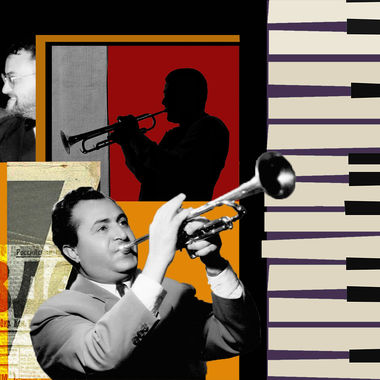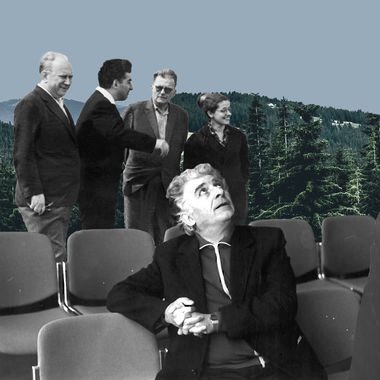
Illustration by Armine Shahbazyan.
Whenever conversations revolve around movies such as “Star Wars,” “The Godfather” or “Once Upon a Time in America“ – films that revolutionized the industry – the scores are invariably recognized as one of the standout factors. Unfortunately, the same cannot be said about contemporary Armenian films and TV series, most of which fall woefully short in regards to soundtrack.
Music in film helps audiences connect with the characters, allowing us to feel and better understand what the character is experiencing, whether it‘s heroic self-sacrifice or falling in love. Music creates the atmosphere and breathes life into the world in which the film is set.
A professional soundtrack can do all this and more for a film. However, a poorly written or selected score can do the complete opposite, utterly altering or disrupting the intent and emotions of a film and creating an imbalance that can leave us detached from the characters, their feelings and the movie as a whole.
It is therefore quite tragic that the majority of the music we hear in contemporary Armenian films and TV-series are simply plucked from the Internet with little regard for copyright issues, professionalism or the suitability of the tracks.
This, however, was not always the case. There was a time in the distant past when scores in Armenian films were deemed pivotal, and Armenian film directors of that era approached music with the respect it deserved.
Film production was a very serious matter for the Soviet Union, possibly because they believed the best way to enforce their ideology was through subtle propaganda inserted into various forms of media. As a result, three years after Armenia became a Soviet state, the USSR opened a movie production studio in Soviet Armenia called HayFilm (ArmFilm), a huge facility that wielded all the required specialists to create professional Armenian films, in addition to people who could dub films from other Soviet countries, with the lion’s share coming from Russia.
And so, the launch of the Soviet Armenian non-silent film industry precipitated the dawn of Soviet Armenian film scores.
1935 saw the premiere of “Pepo,“ the first Soviet Armenian sound film, which told of a flawed system in 19th century Tbilisi where the victim could become the defendant in court. As this was the first Soviet-Armenian sound film, the production team wanted to ensure everything was perfect, particularly the music, so they chose none other than Aram Khachaturian to compose the score.
At the time, however, the usage of music in film was different as it was embedded in the narrative rather than serving merely as an atmospheric layer. The movie would usually begin with a musical theme, but later the music would be heard only when musicians were visibly playing or when one of the characters was singing. In other words, the source of the music that was heard in the film had to also be in the film. It was less used as a tool of storytelling than it was as a part of the story itself.
As expected, Khachaturian did a stellar job and the film became a huge hit not only in Soviet Armenia but also in other Soviet states. The music and songs in the film, particularly “Pepo‘s Song,“ the lyrics for which were written by renowned Armenian poet Yeghishe Charents, grew very popular – so popular in fact that today it is considered a traditional folk song. With his accomplishment, Khachaturian certainly set a very high standard for Soviet Armenian film music.
In 1958, HayFilm wowed the public yet again with two more masterpieces featuring exceptional scores. “Song of First Love“ tells of a talented singer who was spoiled by his fame and success. The music, however, was deemed mediocre, so in order to compose a more fitting score the producers called on two of the greats – Arno Babajanyan, who was a master of the Soviet pop (estrada) genre; and Ghazaros Saryan, a great classical composer and son of famous painter Martiros Saryan.
The collaboration resulted in iconic songs and film scores, including “Song About Yerevan,” “Pretty Girl of Yerevan” and “Song of First Love,” which continue to be played and rearranged to this day. It was during those times that soundtracks began to evolve, becoming more like those of today which, besides great songs, feature orchestral music during different scenes keeping the atmosphere and narrative intact, allowing audiences to feel more connected to the characters and feel the suspense during action scenes.
Another notable work “Why Does the River Make Noise,“ is considered to be one of the greatest Armenian films. This gem tells of an Armenian man taken hostage during WWII, or “The Great Patriotic War,“ who following the conflict appeared on the far side of the river separating Turkey from his village in Armenia.
Extremely moving, this work entices a great deal of emotion, mostly by way of the sublime music written by Artemi Ayvazyan. Besides the songs that have since grown extremely popular, the film’s music by Ayvazyan became revolutionary. In fact, a small motif from the composer‘s score became the icon of the Armenian protest movements that took place in the late 1980s and early 1990s calling for Armenian independence from the Soviets.
With a young lone trumpeter, the film’s score became the anthem of the Armenian revolution as well as a sign of solidarity. Even during the 2018 Velvet Revolution, on different streets one could hear the famous motif of the revolution.
Still, some consider that the two films that had the biggest impact on Soviet and modern Armenian audiences were “A Piece of Sky” (1980) and “The Tango of Our Youth” (1984), both of which owe their scores to Tigran Mansuryan. However, when the music in these two works is compared to the above-mentioned examples, something very interesting grows apparent.
Earlier successful movies usually featured songs that the main characters would sing to express certain emotions. But in the latter two films, soundtracks finally shifted to not only setting the atmosphere, but also to telling the story itself. They reflected not only the moment or the scene, but also the characters and their sentiments. Much like the film itself, these soundtracks had a beginning, a crescendo and a conclusion.
These are but a few examples of Soviet Armenian classical films that in large part owe their success to their soundtracks, most of which were written especially for the movies, sometimes with as many as two composers.
Therefore, we can safely assert that not only did Soviet Armenian film directors and producers give great importance to the soundtrack in films, but they also worked closely with major composers to achieve the precise mood and atmosphere they wanted the film to have. Because of the public acclaim, many of these films are now considered classics and continue to be screened to this day.
Unfortunately, with the collapse of the Soviet Union came the collapse of the “Armenian soundtrack culture.“ Although the late ’80s and early ’90s were extremely difficult for all post-Soviet countries, Armenia was hit particularly hard, with an economic crisis, electricity shortage and war resulting in a cultural crisis. The funding that cultural organizations like HayFilm received from the government was cut while the money that once financed the productions of films and soundtracks was redirected to the Defense Ministry (or State Defense Committee as it was called at the time).
Leaving the Soviet Union also meant a shift to privatization. HayFilm, which was responsible for almost all movie production in Armenia, was among those organizations that were privatized with the hope of restarting it as the film production center of the newly independent Armenia.
Had things gone according to plan, Armenia’s film industry would have continued its progression liberated of supervision from the Bolshevik “big brother.“ Unfortunately, the plan failed, the studio was resold many times and intentions to revamp HayFilm came to nought. Nevertheless, smaller Armenian film production companies like Sharm Holding began to form and Armenian film production resumed.
Regrettably, although films such as 1997’s “Our Yard,“ a musical-comedy that told stories of people’s lives in their beloved building and its communal yard, met with success, the quality of the soundtracks were a far cry from that of Soviet-era Armenian films
While “Our Yard” is considered a classic and is widely popular, the production, particularly, the music in the film is less than inspiring. Despite the film being a musical, rather than hiring a composer to write the songs and score, the production team decided to take famous international and local songs – some from Soviet Armenian films like “The Song of First Love“ – rearrange or re-record them and change the lyrics to fit the film’s plot and scenes.
The rearrangement of the music was done almost completely digitally, giving the film a much more lackluster and unprofessional feel. Still, we must acknowledge the difficulty of producing a film after a major economic and cultural crisis, especially as its purpose was in a way to lift the spirits of the Armenian people after a depression that lasted nearly a decade. And even though “Our Yard” set a very low standard for the future of Armenian film music, it also became a beacon of hope for film producers in Armenia.
Armenia’s increased access to the Internet dealt the “soundtrack culture“ its final blow. Producers, rather than hiring composers, commonly resorted to the destructive and unprofessional practice of simply downloading whatever music they wanted, behavior that was encouraged by the near-absence of copyright regulations in this small post-Soviet country.
As cheaply and unprofessionally made TV dramas grew more popular, film producers grew even less concerned with the quality of the music they used, of course with some with rare exceptions such as “Rock Opera.“
However, although to this day most Armenian films and TV series continue to use music downloaded from the Internet with no regard for copyright issues, suitability or the overall dignity of the music in their films, in the last decade film producers and directors have started to reconsider the importance of soundtracks and are slowly starting to hire composers to write the music.
A good example is “The Line,“ which premiered in 2016 and is considered to be one of the best movies produced in Armenia after the collapse of the Soviet Union. The film had not one but three composers working on it, including Armen Martirosyan and Andranik Berberyan, who were responsible for the orchestral scores; and Artur Grigoryan, who was responsible for the songs.
The three men accomplished their task to perfection, writing music and songs that superbly fit and expressed the film’s story, atmosphere and emotions. In fact, the themes Martirosyan and Berberyan wrote for characters and scores for specific scenes were pivotal to the acclaim the film received from the public and film critics.
Although the Armenian film music industry grew complacent for a period following the collapse of the Soviet Union, it’s undoubtedly re-emerging and Armenian composers are more than ready to unleash their talent in this new era.
also read
Astrophysicist Garik Israelian on Starmus, the Music of Stars and Gravitational Waves
By Tatev Mkrtumyan
Dr. Garik Israelian led the international collaboration that provided the first observational evidence that supernova explosions are responsible for the formation of black holes.
New Music: A Conglomerate of Ideas and Solutions
By Artur Avanesov
What is New Music and why is it not thriving in Armenia? According to composer and musician Artur Avanesov, New Music is a vibrant conglomerate of ideas and solutions, a vast network of communications, pretty much like a modern metropolis; it pushes boundaries and is a search for new sounds and forms.
Armenia’s Path to Getting Copyright Right
By Hovsep Markarian
Artists have been facing a real problem in Armenia: not getting fairly compensated for the music they release. In an age when sales of physical disk copies have drastically declined, with concerts and tours put on hold because of a pandemic, how are musicians supposed to get by?
Retro Sounds in a Digital Format
By Gayane Ghazaryan
What happens when we search Armenian artists from the 20th century on the Internet? If we’re lucky, we might find a video or two and bits of information. It’s not because Armenia doesn’t have its legacy in folk music, jazz or classical music but because the tunes have been locked away in archives, something that is about to change.
From Censorship to State Sponsorship: The Fate of Jazz in the Soviet Union and Armenia
By Gayane Ghazaryan
Jazz and Armenia have a complicated history. From its early beginnings under Soviet rule to contemporary interpretations of jazz, the genre is part of the fabric of Armenian cultural life.
Musical Dilijan: The Cultural Hub of Soviet Armenia
By Arpine Haroyan
The resort town of Dilijan in Armenia is known for its lush mountainous landscapes. It is also home to the Composers’ Union Resort, a place that hosted world famous composers in the 1960s and became a cultural hub in the former Soviet Union.









